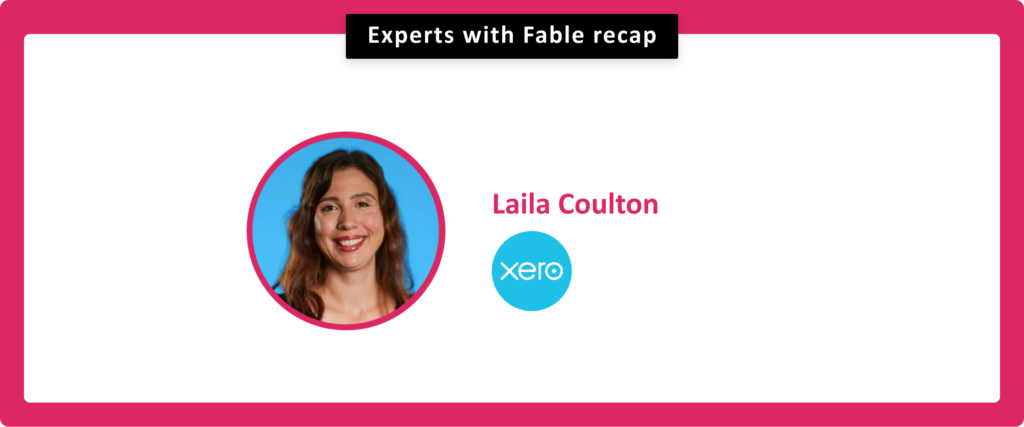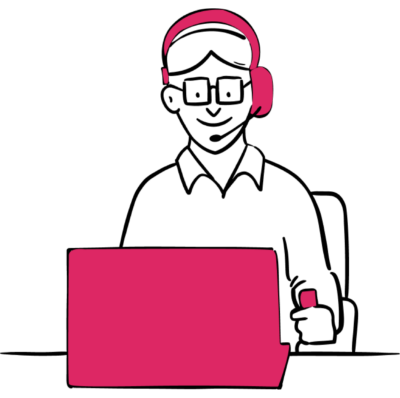
Dispel myths and gain buy-in
Experts with Fable recap: Dispelling myths around accessibility, usability, and design
Experts with Fable is an ongoing webinar series where UX designers, researchers, product managers, engineers and accessibility professionals from leading companies discuss their digital accessibility projects, lessons, and strategies. To stay in the loop about future Experts with Fable, follow us on LinkedIn or sign up for our newsletter.
Executing a scalable accessibility program can face many challenges – there may be limited exposure to and understanding of disability across the organization or a small handful of champions trying to create awareness but have limited reach.
This time, Samuel Proulx, Accessibility Evangelist at Fable sat down for a conversation with Laila Coulton, Head of Design, Research, and Accessibility at Xero. The two covered a wide-range of questions around getting buy-in for accessibility, upskilling teams with the accessibility knowledge they need to get started, and practical insights from Laila’s years of experience getting organizations started on their accessibility journeys. This blog captures the highlights of this event, and check out the event recording for the complete discussion below – including how Xero leverages both Fable Engage and Fable Upskill to drive their accessibility initiatives forward.
Busting accessibility myths
“I find when I first start working within an organization and talking about accessibility, we have to go through that myth busting phase.” — Laila Coulton
There is both learning and unlearning required to begin the accessibility journey at any organization. Some of that unlearning involves correcting common falsehoods that stakeholders may believe about accessibility.
Myth one: the numbers game
“We don’t want to start talking about the numbers of customers we have with disability using the product, because we don’t feel like that’s helpful.” – Laila Coulton
While it is important and useful to talk about the numbers of people with disabilities using a product in the initial stages of getting buy-in, it can lead teams into a trap. Firstly, it can cause organizations to believe that accessibility will only benefit those users who identify as people with disabilities. This couldn’t be further from the truth; accessibility benefits everyone by creating interfaces that are attractive, easy to understand, and easy to use. Secondly, it can cause organizations remediating existing products to prioritize accessibility issues based on the number of users effected, rather than on the severity of the effects, or their frequency. If we focus too narrowly on these numbers, it can result in a compliance-based accessibility program that doesn’t create better experiences for anyone.
Myth two: accessibility is ugly
“The second [myth] being that if we make it accessible, we’re also making it not only ugly, but also unusable. And there’s this perception that accessibility is shifting access away from the current user-base into a different user-base, which is a flawed view from the beginning.” – Laila Coulton
Accessibility isn’t about making things less beautiful, more difficult, or overly simplistic. If you’re putting up barriers for one group of users, to take them down for a different group, you’re not actually doing accessibility. This belief that accessible user interfaces need to be simplistic and unattractive has, in the past, lead to unworkable solutions like text-only interfaces and screen-reader detection. Instead, organizations need to understand that accessible interfaces are human interfaces; once we understand that the more accessible an interface is, the more beautiful and user friendly it is, it becomes obvious that investing in accessibility is a win for everyone.
Getting across the idea that accessible interfaces are beautiful interfaces is a topic that Laila is passionate about, and that she weaves into all her work. Read more of her thoughts on this topic in an article she wrote on Medium called ‘Why Accessible Must Equal Beautiful’.
Myth three: accessibility is hard
“The next hurdle tends to be the perceived difficulty and the skills gap. One of the things that we tend to encounter is that we’ll have people that want to make the product accessible, but they don’t know how to, and… [that] stops them from starting.” – Laila Coulton
Accessibility can feel overwhelming to people who are just getting started. The Web Content Accessibility Guidelines are complex, verbose documents. While they have a valuable place in accessibility efforts, presenting them to people new to the field can do more harm than good. Instead, it’s far better to break accessibility down into small, applicable techniques that each person can use as part of their daily work. Start with getting them to understand and implement one concept, before moving on to the next. Simplicity is far more successful than trying to do everything all at once.
Getting started as an organization
In the same way that it’s important to break accessibility down into small steps for the individual contributor, it’s equally important to do the same thing for the organization. No company can do everything all at once. In that spirit, here are some things that Laila has found helpful as she starts organizations down the accessibility journey.
Meet people where they’re at
“We don’t want to try and hold people to an impossible standard that they can’t meet from the beginning. If the team is at a point where they can do a quick accessibility check, then let’s teach them how to do a quick accessibility check. Something that they’re able to do, that they’re able to achieve and get satisfaction from.” – Laila Coulton
Far too often, rather than inspiring people to build beautiful things, accessibility becomes a stick used to punish them. It becomes about consequences, requirements, and legal liability. Threatening people into making accessibility products, or scaring them into doing it, is almost never successful. We need to start slowly, teach the how and why, and help everyone advance on the journey. Once people are inspired to do better, rather than held to an impossible standard they don’t know how to meet, they begin not only engaging with accessibility themselves, but also spreading the word to their co-workers.
Close the knowledge gap
“It’s hard to get people to make the time to do the training. I’ll be really honest. …But once they’re in, we get flooded with compliments about it, and then people will of their own accord go in and [do the training]. Then they will go out into [our Slack channel] – that reaches 600, 700 people – and say, “I just did the introduction to digital accessibility course. It was amazing. I’m crying. I didn’t realize.”” – Laila Coulton
Organizations need to offer robust, role-based training to ensure that everyone has the skills to build accessible products. But for this training to be accessible, Laila identified a few factors that she finds are critical to any training being successful.
First, it needs to be self-serve. In-person training for hundreds of different people, with differing needs and skill levels, isn’t scalable. Getting people into the training is hard enough, without needing to factor in scheduling and other difficulties. Self-serve training allows people to complete it at their own pace, at a time that works best for them.
Second, it needs to be beautiful. If the accessibility training isn’t just as attractive, easy to use, and fluid as everything else employees interact with, this will tend to reenforce the false beliefs they may have already held that accessibility is ugly and difficult.
Lastly, it needs to expose people to actual users with disabilities. Everyone who works in accessibility knows that the best way to get people to understand and be inspired by accessibility is to put videos of actual users in front of them. This helps to humanize the problem, and help them understand that they can easily contribute to fixing it.
“And what was really important to me is that that online training needed to feel beautiful and usable and accessible. And what I really liked about the Fable product was that it’s a really polished product.” – Laila Coulton
Communicate
“We launched our accessibility@Xero mailbox, and we definitely didn’t celebrate it enough internally, because we had no idea of the actual impact that had on our customers until we launched it. We got some recognition in New Zealand for having an accessibility@Xero.com mailbox, and it was a very small thing for us to do on our side that made an enormous impact for our customers because it’s enabled our customers to have a dialogue with my team about the experiences that they’re having when using the product….We escalate all of the barriers and the issues that we find within our product teams. It was a huge win for our customers.” – Laila Coulton
Communication is at the core of accessibility: communicating to leadership about the value and impact of accessibility, communicating with other teams about the requirements, and communicating the knowledge everyone needs to effectively improve accessibility. But with all this internal communication, we need to make sure we’re not forgetting to communicate externally as well. Something as simple and easy as creating an accessibility email address can allow organizations to hear directly from customers with disabilities, helping to understand their actual needs. It can also help reassure customers that the organization understands and is committed to creating accessible products. The key, however, is transparency and honesty. It’s OK to be up-front about the current state of products, and the efforts the team is making to fix them.
Conclusion
“[Accessibility] is the ultimate challenge for creativity, and I think this is what makes engineers and designers want to come to work: trying to make really complex things usable. I think that there’s always a way to explore [accessibility], but you need to do user testing. You cannot explore it in isolation unless you are someone with a lived experience of disability, and even so your experience is unique to you; you must test it. It’s all about experimenting: test and learn, and test and learn, and keep trying until you get it right.” – Laila Coulton
The key takeaway, however, is that no matter where your organization is currently, or what role you play their, you can contribute to moving accessibility forward. It could be by learning as an individual, by creating or joining an accessibility champions group, or by advocating for accessibility to be part of your organizations regular practice.
Watch the full webinar to learn more from Laila and Sam
Learn more about accessibility testing and training
Questions about how you can bring insight from people with disabilities into your product design and development cycle?

